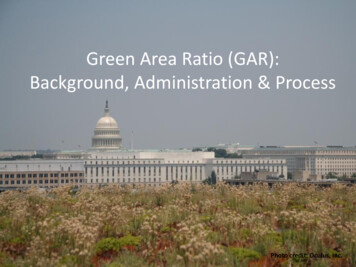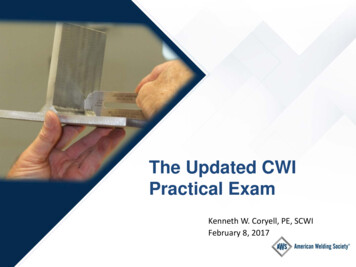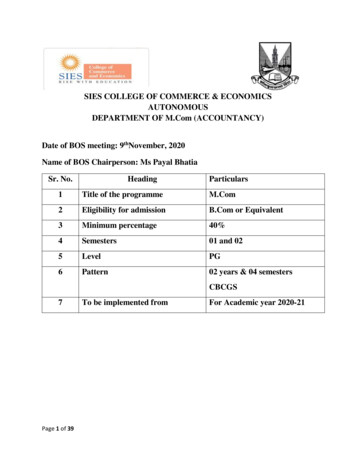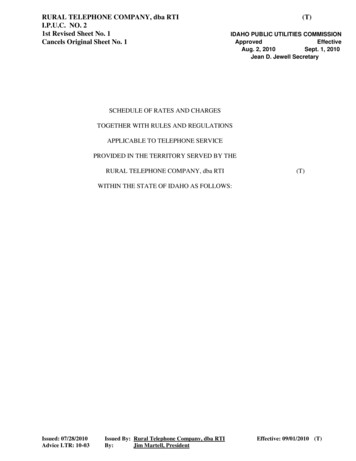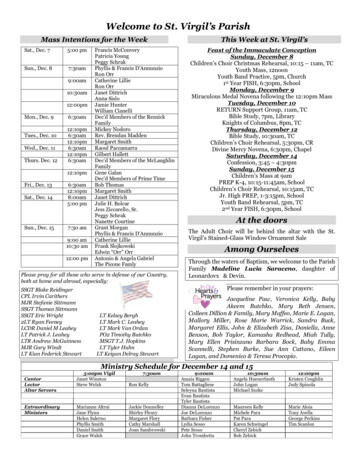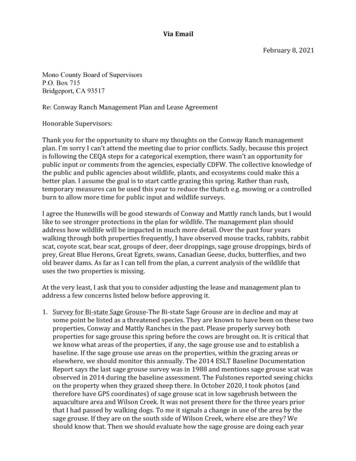
Transcription
Via EmailFebruary 8, 2021Mono County Board of SupervisorsP.O. Box 715Bridgeport, CA 93517Re: Conway Ranch Management Plan and Lease AgreementHonorable Supervisors:Thank you for the opportunity to share my thoughts on the Conway Ranch managementplan. I’m sorry I can’t attend the meeting due to prior conflicts. Sadly, because this projectis following the CEQA steps for a categorical exemption, there wasn’t an opportunity forpublic input or comments from the agencies, especially CDFW. The collective knowledge ofthe public and public agencies about wildlife, plants, and ecosystems could make this abetter plan. I assume the goal is to start cattle grazing this spring. Rather than rush,temporary measures can be used this year to reduce the thatch e.g. mowing or a controlledburn to allow more time for public input and wildlife surveys.I agree the Hunewills will be good stewards of Conway and Mattly ranch lands, but I wouldlike to see stronger protections in the plan for wildlife. The management plan shouldaddress how wildlife will be impacted in much more detail. Over the past four yearswalking through both properties frequently, I have observed mouse tracks, rabbits, rabbitscat, coyote scat, bear scat, groups of deer, deer droppings, sage grouse droppings, birds ofprey, Great Blue Herons, Great Egrets, swans, Canadian Geese, ducks, butterflies, and twoold beaver dams. As far as I can tell from the plan, a current analysis of the wildlife thatuses the two properties is missing.At the very least, I ask that you to consider adjusting the lease and management plan toaddress a few concerns listed below before approving it.1. Survey for Bi-state Sage Grouse-The Bi-state Sage Grouse are in decline and may atsome point be listed as a threatened species. They are known to have been on these twoproperties, Conway and Mattly Ranches in the past. Please properly survey bothproperties for sage grouse this spring before the cows are brought on. It is critical thatwe know what areas of the properties, if any, the sage grouse use and to establish abaseline. If the sage grouse use areas on the properties, within the grazing areas orelsewhere, we should monitor this annually. The 2014 ESLT Baseline DocumentationReport says the last sage grouse survey was in 1988 and mentions sage grouse scat wasobserved in 2014 during the baseline assessment. The Fulstones reported seeing chickson the property when they grazed sheep there. In October 2020, I took photos (andtherefore have GPS coordinates) of sage grouse scat in low sagebrush between theaquaculture area and Wilson Creek. It was not present there for the three years priorthat I had passed by walking dogs. To me it signals a change in use of the area by thesage grouse. If they are on the south side of Wilson Creek, where else are they? Weshould know that. Then we should evaluate how the sage grouse are doing each year
during the lease to determine if the cows have an impact on the sage grouse there ornot. If so, then changes should be made to better manage the property for the sagegrouse.2. Grass height should be spelled out-Best management practices related to sage grouserecommend 7-inch grass height. The NRCS management plan does not specify a grassheight. It just says the grass should remain tall enough to grow back. In practice, that ismuch shorter than 7 inches. If no sage grouse use the property, then following theNRCS best management practices would suffice. However, if there are sage grouse onthe property, then the sage grouse need better cover and the lease should be changed tospecify a 7-inch grass height and where. In support of the sage grouse, grass should beallowed to grow at the edge of the sagebrush with fencing a sufficient distance from thesagebrush to provide a buffer zone.3. Safer fencing for wildlife- How will this extensive fencing affect wildlife? How high isthe fencing? Why not make all fencing drop down fencing? Then deer could migratethrough in the spring and fall without adjusting their route. It would reduce the risk ofsage grouse hitting the fencing and would eliminate perches for ravens during thenesting season. Mono County has been participating in the BSSG LAWG and protectingthe sage grouse whose main population is in the County. Perches for ravens, i.e. fencing,are the biggest threat for this species. Ravens raid the eggs so the sage grouse can’tmaintain or increase their population.Flagging the fences is essential and I appreciate that it will be done, but it is still anelectric fence. What happens if birds strike the electrified wire? Is an electric fencenecessary? The NRCS management plan does not state that the fence should beelectrified. I assume the fence will only be electrified when cows are in the pastures.How will this be communicated to the public? If the fencing isn’t drop-down fencing,then signage should be changed to tell the public when the electricity is off. Lay-downfencing would allow locals to cross-country ski the meadows in winter.4. Protect the creek-The cows should not be allowed in Wilson Creek or the Wilson Creekravine. The ravine is a diverse and dense riparian corridor and heavily used by wildlife.The fencing should keep the cows out of the creek and out of the areas where it forms apond behind the old beaver dams. The fencing map in the packet shows fencing right upto the pond. Migrating birds use that pond. It should not be muddied or filled with cowdung. The fencing should keep cows away from the pond and far enough away toaccount for high water years when the pond expands.5. Leave meadow for pollinators-It appears that all the meadow area on the north side ofWilson Creek will be enclosed and therefore, unusable for wildlife. That leaves nomeadow to support of butterflies and pollinators. Kristie Nelson has entered numerousobservations in iNaturalist of insects and butterflies on Conway Ranch and on MattlyRanch. I have walked through the meadow on the east side of Conway Ranch when itwas full of butterflies. It would be another take-away to biodiversity when one of thegoals of the easement is to maintain biodiversity. Please leave some of the meadow andclean muddy areas outside of the fenced area as butterfly and insect habitat. We shouldbe preserving part of the habitat they use.
6. Retract fencing on west side of Mattly-The fencing map shows fencing on the east sideof Mattly Ranch on or right up against the dirt road that runs north-south parallel to thecreek. There is a power line to the west of this dirt road that would be enclosed. Thefence should be to the west of it. People ride ATVs along that dirt road as well as walktheir dogs there. A little bit of a buffer zone would be better for all.7. Have a baseline for water quality-The watering map shows two irrigation ditches thatleave a grazed area and then drain into Wilson Creek; one on Mattly and one on Conwayranches. Wilson Creek water quality should be tested annually for fecal coliformbacteria, TDS, oxygen, and nitrates downstream of Conway Ranch to ensure the water isclean. There are state laws requiring protection of water quality and limit the amount offecal matter in a water body. The water should be tested prior to the cows coming on tothe property to set a baseline. Please harden any areas where cows get water from theirrigation ditches, ponds, or springs on the property.8. Assess in two years-Re-evaluate the biodiversity and health of the ecosystems after twoyears before automatically increasing the number of AMUs as is planned. Thenadjustments can be made to the management plan as needed to prevent loss ofbiodiversity.I would like to see the County include more protections and habitat for wildlife in themanagement plan before the Board of Supervisors approves it. An inventory of the wildlifeand plants should be conducted by botanists and wildlife biologists who know theappropriate protocol for such surveys and the appropriate times of year to systematicallycollect this information for both breeding and migratory species. Information from thesurveys would then feed into a more accurate and well-informed management plan. Manyof us asked for this in 2017 and I ask it again.Regards,Lynn BoultonLee Vining
February 8, 2021P.O. 349Lee Vining CA 93541deannad350@icloud.comSubject: Concern about Grazing Impacts to Wildlife and Habitat at Historic Mattly RanchDear Mono County Supervisors,Greetings. Thank you for the opportunity to provide important comments on the proposedlivestock grazing at the Historic Mattly Ranch area. I have not been engaged in the ConwayRanch planning, however, I have just recently learned that the Mattly Ranch area is now underconsideration for livestock grazing with just a week notice to the public for comments on theproposed Categorical Exclusion on Mattly Ranch livestock grazing proposal. For the record,I believe Mattly Ranch should be excluded from ranching and livestock grazing permits,and the existing status quo should be continued for the benefit of wildlife and habitat.The importance of protecting natural landscapes is heightened in our current times asincreasing pressures of warming climates are exponentially increasing wildfire, droughts,and impacts to water availability impacts to wildlife. All of these and the additional stressof livestock grazing. would add yet another devastating effect on the quality of habitat andthe viability of wild flora, fauna, and ecosystems. It is essential that Climate Change andAdaptation Strategies should be integrated into planning for current and future timeframes, and these intensifying impacts in of themselves warrant removal of the proposal oflivestock grazing at Mattly Ranch and support of wildlife sustainability. The decline of thehealth of the deer is well known. Yet another stressor added to their survival in the presentand future as their ecological, migratory, and potential climate refugia are degraded effectsdeer, and sage grouse, and the web of life.Additionally, and practically speaking it is not in the best interest of the county’s resourcesas analyzing and administering a new ranching allotment in the Mattly Ranch area is costlyand labor intensive. A categorical exclusion is not an appropriate environmental analysis.A CEQA analysis appears to be the proper legal approach to as Mattly livestock grazing ishistoric and is now a new proposed use. This would substantially increase the county’s workloadto comply with the CEQA requirements and would be a lengthy process to develop biologicalresource inventories, sound analysis by subject matter experts, clearly articulated the alternativesand impacts in the public comment process that a minimum would be an environmental analysis.Additional time would be required to develop mitigations that include robust inventory,monitoring, and adaptive strategies that need to be presented to the public for comment.However, if pursued, I am willing to contribute my naturalist knowledge to inform theenvironmental analysis of this living ecosystem and to develop strategies for wildlife.Any potential use in the Mattly Ranch needs to be appropriately responded to that includesthe Mono County residents (and taxpayers) who have a right to participate in decisions onpublic lands. This would include whether it is the highest use, most appropriate use, and towhat level and extent grazing would occur, and what mitigations would occur and adaptivemanagement strategies required. This folds into the CEQA requirement of a new use ofland that would require biological/ecological inventory and assessments, monitoring andadaptive management processes. A current assessment is needed that addresses currentconditions, projected conditions of impacts of a warming climate, and impacts on ecological and1
migratory corridors. If livestock grazing were to occur, there also need for a CEQA analysis andprovisions that address water use in the area that prioritizes adequate water for wildlife and withreductions in A.U.Ms in drought years.Cultural Resources: Has the Historic Mattly Ranch been inventoried and evaluated forcultural resources and submitted to State Historic Preservation Officer for a categoricalexemption for this proposed non-historic use?Additionally, the Mattly Ranch area both including the road and also the adjacentlandscape has become a recreational area for multiple uses of wildflower wonders, bird andwildlife watching, mountain biking, running, and hiking, and in winter cross country skiing.Is fencing a realistic solution? Fencing is a necessity if grazing occurs, however the bestsolution is no livestock grazing. The perimeter of the fences must take into account the needs ofthe deer and other wildlife needs and movements and must be wildlife friendly in height and lackof barbs. Fences must not limit access for wildlife from the canals were wildlife access water.The NE corner of the meadow must not be fences as it includes a drainage from the slope aboveto critical cover area for wildlife with water and cover for deer and wildlife. Fences need to limitthe meadow acreage and also prevent cow trespass into the vitally important aspen groves abovethe Historic Mattly meadow. This is important as cows trampling in the aspen groves would bedisruptive to the does and fawns there, as well as competing for the delicious and nutritiousgreens growing in this wet and shaded areas. To prevent this loss of fawning areas, cover,shelter and food, it is much easier to not permit ranching and the imperfect mitigation offencing, and to choose to protect habitat and wildlife where fencing would not be needed.It is of high importance to develop biological resource inventories, sound analysis by subjectmatter experts, and clearly articulate the alternatives and impacts in the public commentprocess that at a minimum would be an environmental analysis. Developing mitigations thatinclude robust inventory, monitoring, and adaptive strategies need to be presented to the publicfor comment. If ranching analysis of alternatives proceeds, adequate mitigations must beidentified and budgetary resources of inventory and regular monitoring and management foradequate oversight that the terms and conditions of the permit are adhered to, and an adaptivemanagement strategy for impacts to wildlife including sage grouse, deer, ecological andmigratory corridors, vegetation and recreational impacts.Governor Newsom announced on October 7, 2020 a statewide policy to protect 30% of CA by2030 and that manage public lands including state lands are to be managed for their biodiversity,as natural solutions to climate change, and life support systems as a strategy for a livable planet.The importance of these livable ecosystems are vital for the survival of fabric of life that we soappreciate, and don’t want to disappear due to lack of foresight.As I travel the road corridor along 395, there is a substantial amount of grazing along theroad corridor, and some of these are likely to remain, so this is an opportunity to leave someof the scenic corridor of highway 395 beautiful open space where wildlife is thriving and thechance of a lucky sighting of a wild creature in a wild place in Mono County known as acounty “Wild by Nature.”Sincerely,/s/Deanna M. DulenAttachment: Citizen observations of wildlife in the Historic Mattly Ranch meadows2
Attachment: Citizen observations of wildlife in the Historic Mattly Ranch meadowsAs a long-term Mono County resident since 1991, I have hiked on the Mill Creek Power Plantroad, hill sides, meadows, and adjacent to and up the road to Jordan Basin observing the cyclesand movements of deer and fawn, meadowlarks, sage grouse, towhees, bluebirds and lazulibuntings, hawks, and vultures. I watch the tracks of bobcat, badger, foxes, coyotes, and smallmammals, and mountain lions whose survival is woven into this ecosystem. Of note, MonoCounty’s bobcats are just beginning to recover from a very targeted trapping for their fur for bothlegal and illegal export, which has been stopped with the trapping ban on bobcats.During the spring bloom in the sagebrush, there is a spectacle of colors of mule’s ears, arrowroot,lupine, penstemon, and several species of lilies in the Mattly Ranch meadow areas and in theaspen groves. Although at a first appearance this may appear as a monotone of sagebrush ocean,this is a flourishing web and circle of life. Walk quietly amidst the vibrant spring festival of colorand listen to the singing meadowlarks and courting towhees and bluebirds, sage grouse and theirchicks in a scurry for safetyFor decades, I have been watching the resident herd of does, juveniles, and fawns traverse theslopes about the road and then descend down into the NE corner of the meadow where there is aslight depression when spooked by people or vehicles. I have also seen them grazing on themeadow grasses. As the does are fawning there are several day beds, that when thirst and hungercompel them to descend across the road to the meadows below and also as the seasons progress tothe aspen groves that are above the meadow.We are all sadly and keenly aware of the increased stresses on humans and landscapes from theaccelerating climate crisis of increasing heat and drought stress on meadows, forests, andecosystems. However, although we may not yet know the specifics of impacts to the great andsmall creatures in our shared “Wild by Nature” Mono County, it is logical that losing yet anotheropen space where wildlife is dependent there will be negative impacts on their habitats. Thesewill occur throughout the seasons and their lifecycles and disrupt the food & habitat and denning,and their movements both during the spring, summer and fall, and also many of the deer in theJordan Basin road corridor coming from Jordan Basin to descend to this meadow habitat and thenmove eastward through both Mattly and Conway ranches to the east and their overwintering sites.3
February 8, 2021To: The Mono County Board of SupervisorsMono County Staff: Justin Nalder, Tony DublinoFrom: Ilene MandelbaumRe: February 9, 2021 BOS Meeting Agenda Item: Approval of Categorical Exemptionand Cattle Grazing Lease on Conway and Mattly RanchesI am writing to request that the BOS refrain from approving the Categorical Exemptionand Cattle Grazing Lease on Conway and Mattly Ranches at this time. I disagree withthe staff’s conclusion that granting a cattle grazing lease is not a new activity thatrequires further analysis under CEQA. Rather, it is a decidedly different activity whichhas not occurred on the property for likely a century or more.I ask that the BOS direct staff to undertake a CEQA analysis for the proposed actionthat is based on updated environmental surveys of sensitive resources on the property,which have yet to be conducted, and that include a comprehensive analysis ofpotentially significant impacts to all resources.The County must also consider alternatives to the proposed action, avoidance andminimization of those impacts and mitigation measures. Any decision must also includecomprehensive monitoring requirements to ensure impacts are not greater thanexpected.There must also be an adequate public comment period included in the CEQAprocess.The BOS is meeting on this issue one day before the Mono Basin RPACmeets. The RPAC requested many months ago that it receive updates on any leasingproposals and opportunities for discussion before any actions are finalized by theCounty. Ever since the possibility of a cattle grazing lease has been on the agenda fordiscussion in BOS or RPAC meetings, staff and BOS members have stated repeatedlythat there would be a robust CEQA analysis on any proposals that come forward. Thiswas, I believe, in recognition of the long standing public interest in this County-managedpublic property.I want to acknowledge that Mono County has invested considerable staff time devotedto the hands-on management of property infrastructure, seasonal irrigation and other
resource management. Staff have also produced Operations Reports and Plans, a DraftFacilities Operations Plan with some public input, and have solicited production of otherreports, such as the NRCS Grazing Management Plan. These are all steps in the rightdirection.The Eastern Sierra Land Trust (ESLT) states in their Conservation EasementManagement Plan, under:“(d) Public and Agency Involvement in the Management and Operations Plans”“Mono County will provide the annual Operations Plan prior to a public meeting eachyear in the Lee Vining area so that interested parties can provide comments and input.Updates and changes to the Management Plan will also be provided to the public priorto this meeting. Interested federal and state agencies, including the original grantFunders, will be notified and invited to participate.”I do not believe that this has ever happened.Rather, actions concerning Conway Ranch have been single-issue driven, concerning,initially, a fish hatchery, then whether or not to renew sheep grazing, and now whetherto grant a cattle grazing lease. All the while, community members and commentingbiologists have urged the County to update surveys of biological resources andenvironmental conditions-including rare, sensitive or endemic plants, animals andinsects, including the pygmy rabbit, the Bi-State Sage Grouse and resident andmigratory deer, butterflies, soils and water quality.Alternatives for fuels management and rejuvenation of meadow habitats such asmowing and controlled burns should be considered in a CEQA analysis. A monitoringplan should include control areas from which new activities are excluded.An alternative is that Mono County that has been previously suggested is to pursueacquisition of the property by the State as a Wildlife Area or Reserve. It is important thatsuch an action would not be precluded by granting a grazing lease.In addition, Conway and Mattly Ranches have become increasingly importantrecreational assets to Mono Basin residents and to the adjacent community of MonoCity which has grown considerably since the property was acquired by Mono County.Diverse activities occur year-round, including hiking, botanizing, animal, bird andbutterfly watching, dog walking, running, bicycling, skiing, swimming, photography andappreciation of historic ranch structures.
Recent mention has been made of grants available for recreational improvements. Itwould be ideal if consideration of such proposals were conducted within acomprehensive approach to ranch management with thoughtful public involvement andwith baseline data, rather than in a fragmented manner. An oversight committee orworking group of citizens and involved agencies for comprehensive planning forConway Ranch has been requested throughout the years but never been formed.The bottom line is that cattle grazing is a new activity bringing with it new actions andnew impacts. Fencing will occur in areas never fenced before. Yet how will cattle beexcluded from sensitive habitats such as willow thickets and bogs within fenced areas?There have been only four years of recovery after a century of sheep grazing. The valueof recovery and restoration of biologically diverse native meadow ecosystems, healthylandscape linkages for migratory and nesting species such as mule deer and sagegrouse, improved water quality and water holding capacity and restoration of degradedportions of the property, all should be part of the analysis. Recovery of sensitiveresources is likely to be impeded. Potential impacts on sensitive resources are likely tobe significant and need to be analyzed. The Conservation Easement Management Planrequires that sensitive resources not be impaired. Desired conditions should be definedto be more than maintaining forage for livestock.Thank you very much for your time and consideration of these comments.Sincerely,Ilene MandelbaumPO Box 89Lee Vining, CA 93541monogreens@aol.com
Board of Supervisors, County of Monoc/o Clerk of the BoardShannon KendallPO Box 715Bridgeport CA 93517February 8, 2021Justin NalderMono County Department of Public WorksPO Box 45774 N. School St.Bridgeport CA 93517Via email: skendall@mono.ca.gov, jnalder@mono.ca.gov.RE: Conway Ranch Agriculture Management Project and LeaseAgreementDear Mr. Nalder and Honorable Supervisors,We are providing comments on the agenda item 7E for the February 9, 2021Board of Supervisors meeting concerning converting a currently ungrazed ranch propertyin the Mono basin that was a prior sheep ranch, into a 5-year lease for cattle. 1Western Watersheds Project is a non-profit organization with more than 12,000members and supporters. Our mission is to protect and restore western watersheds andwildlife through education, public policy initiatives, and legal advocacy.The Center for Biological Diversity is a non-profit environmental organizationdedicated to the protection of native species and their habitats through science, policy,and environmental law. The Center has over 1.7 million members and online activistswith over 70,000 members throughout California and the western United States. TheCenter and its members have worked to ensure the conservation of the Sierra Nevadabighorn, Bi-state sage grouse and many other listed, rare, and special status species andtheir habitats in this area that may be adversely affected by the proposal to allow cattlegrazing at Conway /files/fileattachments/board of supervisors/meeting/31128/02feb 09 2021 agenda packet.pdfComments on Conway Ranch Grazing Proposal1
The proposed Mono County Lease Agreement with the Hunewill Land andLivestock Company, Inc. pertains to seasonal grazing of cattle on Conway Ranch, relatedwater pipelines and watering facilities, and the construction/reconstruction of fences.A proposed ordinance would amend Mono County Code chapter 13.40, PublicUse of Conway Ranch, to implement public access restrictions to cattle grazing areasduring grazing season. Mono County would receive lease fees from the grazing of cattleon Conway Ranch. Mono County Department of Public Works recommends approving a5-year lease for seasonal cattle grazing on Conway Ranch using a categorical exclusionCEQA Guidelines Section 15301 (Class 1: Existing Facilities), Section 15302 (Class 2:Replacement or Reconstruction), or both.Because cattle grazing is a new use that will impact resources includingvegetation and water quality, and fence construction and reconstruction may significantlyaffect species such as sage grouse, additional environmental review is needed. TheCounty must fully analyze the potentially significant effects of cattle grazing season-longin meadows and riparian areas above Mono Lake, a prized national recreation area andcontaining sensitive ecological resources, bird habitat, and important migration stopoverhabitat along the Pacific Flyway.In addition, evidence of sage-grouse has been found in the Conway ranch sincecessation of sheep grazing three years ago, as habitat for these declining species isrecovering. Sage-grouse require a minimum of 7 inches of grass height as cover fromraven predators, which are attracted by livestock watering facilities and carrion associatedwith stillbirths and carcasses. Fencing provides perching opportunities for predators andcan significantly impact sage grouse. The design and placement of new or reconstructedfencing must be considered in that context.The Bi-State Distinct Population Segment of greater sage-grouse is in severedecline, especially away from the core areas of the Bodie Hills. As you are aware, DesertSurvivors, Center for Biological Diversity, Western Watersheds Project, and WildearthGuardians sued the U.S. Fish and Wildlife Service in September 2020, for failing toprotect this imperiled bird under the Endangered Species Act. 2In addition, we are concerned about water quality impacts of cattle grazing andmanure management on springs and streams that drain from the Eastern Sierra slopes intoMono Lake and that the Lahontan Regional Water Quality Control Board (LRWQCB)has not been consulted regarding potential impacts. The LRWQCB has authority toregulate grazing activities that may discharge fecal coliform and nutrients, and sedimentdischarges as wastes that could affect the quality of the waters of the State. See WaterCode Section 13260 et seq. Additionally, the LRWQCB has authority to regulate grazingactivities as non-point source discharges. Even if Best Management Practices ents on Conway Ranch Grazing Proposal2
are adopted, voluntary BMPs may not be sufficient to protect water quality and beneficialuses, including for example, erosion problems, destruction or major impairment ofvegetation, or significant addition of nutrients, pathogens and/or sediments to surfacewaters or ground waters resulting from grazing or grazing management activities.Additional environmental review of potential impacts to water quality is requiredand the LWQCB should be included in that process. Because the proposal does notcurrently address water quality or require any water quality sampling, it will beimpossible for the LRWQCB, the County or the public to know if degradation of waterresources occurs. At minimum, the County must obtain baseline water qualityinformation in various seasons at appropriate locations before any grazing begins andrequire regular (e.g. monthly) water quality testing at appropriate locations thereafter.New water conveyance pipelines and watering troughs are proposed for cattlegrazing, which could have unanalyzed impacts on bird and wildlife habitat both on theranch property and in adjacent Mono Lake. Impacts to Mill Creek and Virginia Creek ofnew water diversions must be analyzed as well, as these new diversions could also impactMono Lake.Any concern about ungrazed thatch build-up and fire fuels should be a
sage grouse hitting the fencing and would eliminate perches for ravens during the nesting season. Mono County has been participating in the BSSG LAWG and protecting the sage grouse whose main population is in the County. Perches for ravens, i.e. fencing, are the biggest threat for this species. Ravens raid the eggs so the sage grouse can't

